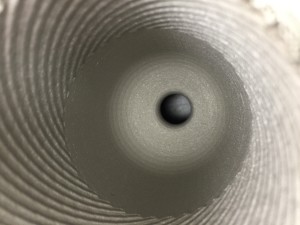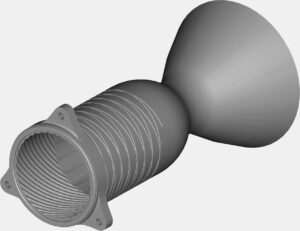Press Forming May Save You Time And Money
September 14, 2015MTI To Sponsor SEDS of UCSD | Aerospace Additive Manufacturing
November 3, 2015What If 3D Printing Was Around in 1990?
3D Printing, also known as Additive Manufacturing (AM) has created a lot of buzz across multiple industries because it enables manufacturing and engineering communities to push away from the table and start with two simple questions, “what does it need to do?” and “how can it be designed to do it best?”
Traditionally, MTI has always explored ways to produce parts economically, yet of superior performance. Consequently, AM was a natural offering to add to the portfolio of services at the company.
As part of the research and development of AM, MTI looked back at some of their projects from over the past 40 years. In the early 1990s MTI produced the Dual Mode Liquid Apogee Engine (DM-LAE). The rocket engines were employed in the Anik E1, Anik E2 and Intelsat-K satellites. Parts were produced using a variety of process steps including forging, spinning, and final machining. MTI was interested in how AM might have impacted the rocket engine’s design.
As part of the experiment, MTI collaborated with Altman Browning and Co. from Portland, Oregon − an engineering and manufacturing services company providing design and analysis for innovative product development. The task was to consider how AM may have been leveraged if it were an available manufacturing process during early ‘90s.
The first challenge to address was how might the cooling performance of the motor have been enhanced. The liquid apogee burn process includes a combination of ignition of, and burning of the liquid propellant, where cooling is of utmost importance with this type of engine. Without it, there would be catastrophic engine failure as the rocket-fuel process produces heat upwards of 4000 Fahrenheit, hotter than the metal can withstand.
Cooling is traditionally achieved by directing evaporating fuel along the wall of the chamber, known as Fuel Film Cooling which functions to reduce engine temperatures to the 2000F degree range.
Keeping in mind that the original motor was designed to produce maximum thrust while not over-heating, the experiment focused on what features could be integrated had the original team of engineers had 3D printing available? Maybe they could have achieved the needed thrust with a smaller motor by expanding the area of the surfaces that the fuel moves along. Indeed, Altman Browning’s conceptual design increases the surface area as well as providing directional paths to potentially influence how the cooling process takes place.
The collaboration between MTI and Altman Browning and Co. allowed a legacy part to be reverse engineered and changed to demonstrate potential improvements to functionality and then ultimately printing those “improvements” in house, out of Inconel 718.
This project is in no way an endorsement of this design but serves as a demonstration of the power and flexibility of AM. It is an exciting time to be in manufacturing and engineering as novel enhancements are built and tested.
Not utilized in this design, but being tested in new rocket motors is the use of internal flow passages that promotes regenerative cooling using the fuel source within the engine body. The process of regenerative cooling also pre-heats the fuel while cooling the motor.
Additive manufacturing is not the answer for every project, but with the process, part-complexity does not necessarily drive additional cost. MTI would be pleased to work with you on your developments if you have a project that includes re-design of an existing or legacy part, or are developing a concept that leverages the power of 3D printing.
About Metal Technology (MTI)
With more than forty years’ experience applying innovative, proprietary technologies, Metal Technology (MTI) is making possible the use of difficult alloys for a wider range of applications with greater efficiency, versatility, and reliability. Alloys include Tantalum, Niobium, Zirconium, Titanium, Tungsten and Molybdenum. MTI uses specialized deep-draw, spinning, forging, machining, EDM, and fabrication methods to deliver superior products according to your exacting specifications. MTI produces components for ion source components, targets, seamless crucibles, explosively formed penetrators, tubing and vessels to custom parts that go beyond common configurations.
Contact us for more information on our additive manufacturing initiatives.



